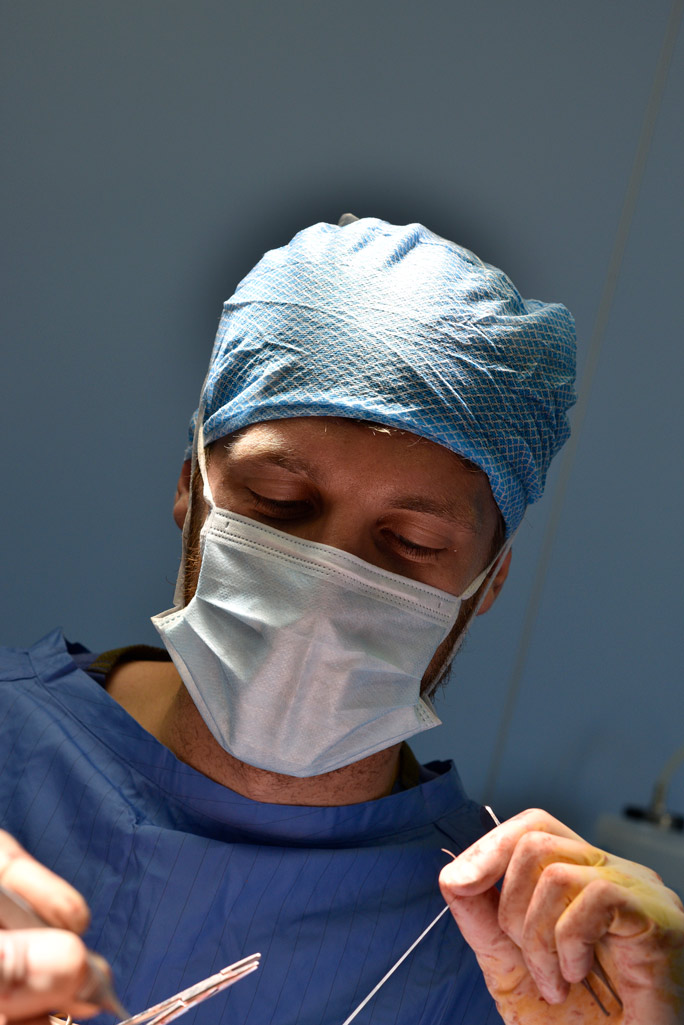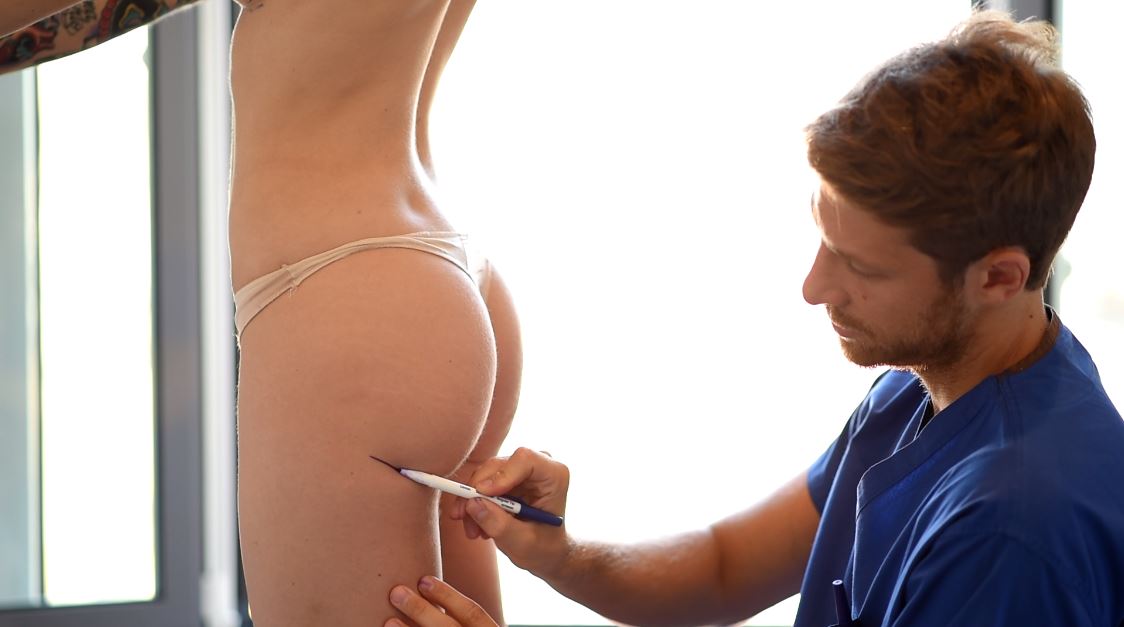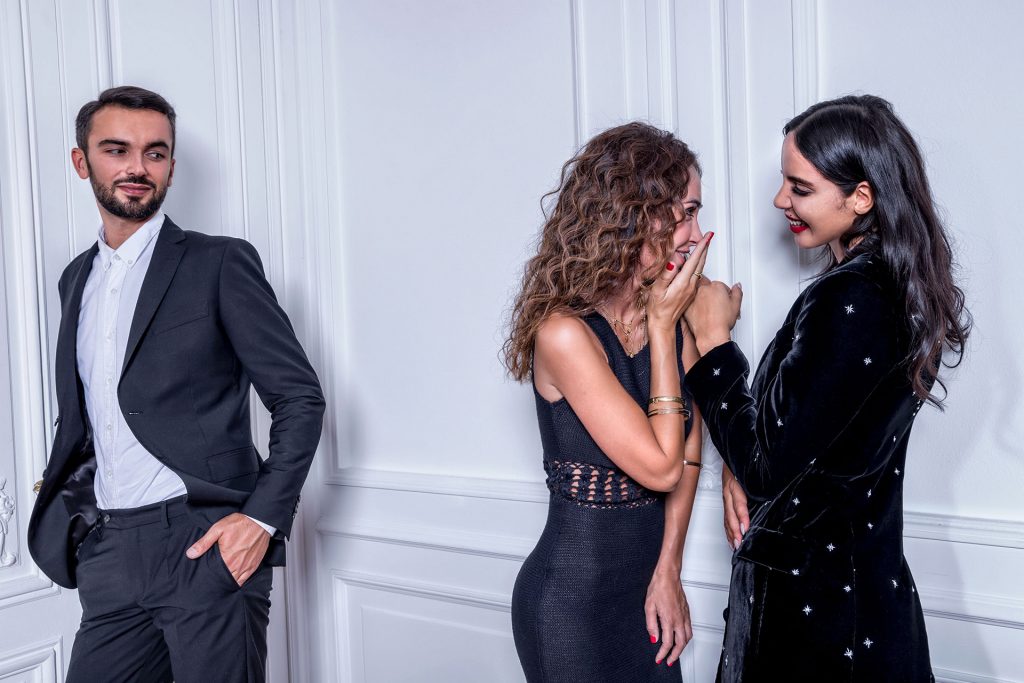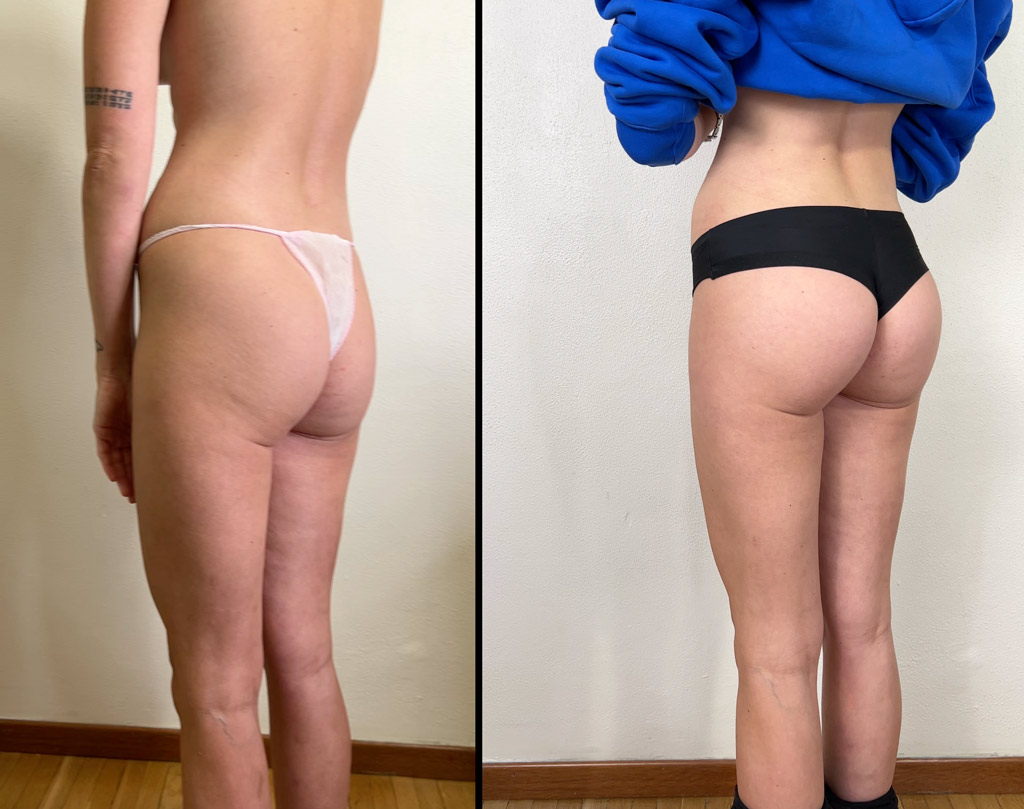GLUTEOPLASTY
Shaping the high and round butt
GLUTEOPLASTY
Gluteoplasty is a method of cosmetic surgery ideal for developing a proper reshape, harmonious recontour, and defining a sensual yet aggressive contour of the buttocks and is not intended, in Western culture, to volumetrically enlarge its size.
From Dr. Mattia Colli the surgical results are cutting-edge and admirable precisely because they derive from a correct combination of different surgical techniques; gluteoplasty is the most important phase.
In fact, the surgery is performed exclusively with an innovative technique and recognized worldwide as the safest and most efficient from the point of view of results: it involves the insertion of the prosthesis no longer inside the large gluteal muscle, but creating an adequate sub muscular pocket that wraps the prosthesis entirely in its thickness and guarantees an extremely natural result.
Thanks to the experience gained and recent techniques, gluteoplasty can be performed with safe and admirable results even in thin people, in which both muscle tissue and above all adipose tissue are scarce; certainly the volumetric decision will influence the final result, therefore the surgical medical examination is always a combination of the patient’s requests and the advice of the Surgeon. In the event that the desired result from gluteoplasty surgery cannot be promised, the surgeon will reserve the right to enlist the help of additional techniques to achieve the goal.
The satisfaction and appreciation for the results obtained from the gluteoplasty surgery is constantly monitored even in the years following the surgery itself. The possibility of having a direct testimony from patients on their experience makes Dr. Mattia Colli, the surgeon with whom you can deal directly to know the satisfactions, clarify any doubts and find the necessary motivations.
The patients, who meet Dr. Mattia Colli come from all over the world. To reduce waiting times you can get an online consultation. An online consultation will give the patient the opportunity to meet the surgeon and establish the confidence needed for a successful surgical intervention.
GLUTEOPLASTY – HIGH AND ROUND BUTT
WHY CHOOSE DR. MATTIA COLLI
The shaping of the round shape and the slender projection of the buttocks, the elimination of fat on the hips and the subsequent covering of the fat at the level of the lateral profile of the prosthesis is one of the main goals with gluteoplasty surgery resulting in an admirable and enviable B-side.
Thanks to the intervention of gluteoplasty, showing and exposing your reshaped body in one of its essential areas gives elegance and self-confidence.
Glutes that have always remained deflated, drooping, with a flat, unremarkable profile, disproportionate and discordant, are shaped and modified to offer a completely different figure and perspective, becoming pleasing and attractive.
At Dr. Mattia Colli the gluteal prostheses used are of the highest quality with CE mark.

GLUTEOPLASTY: TO WHOM IT IS RECOMMENDED
The intervention to obtain a high and round buttock is recommended to all patients who:
- they want to have an image of their body that returns proportionate, harmonious and sensual shapes
- they want to enjoy their own admiration and that of others
- realize the dream of pleasure and pleasure by wearing clothes
- consider self-esteem fundamental to succeed
- they want to increase their self-confidence.
The characteristics of the patient suitable for this gluteoplasty surgical procedure are:
- good health (blood tests and ECG)
- small glutes, flat, drooping, hollow
- hypoplasia or reduced muscle volume
- realistic expectations
Patients eligible for gluteoplasty surgery are not only people with a normal subcutaneous (fat) layer also low-weight and lean individuals.
A variable is the nature of the skin: the patient who has elastic skin and a certain thickness will be able to carry out a volumetric modeling superior to those who have thin and sagging skin. In this last case, the surgeon in a completely transparent way will have to resort to the use of additional surgical techniques of gluteoplasty in order to better standardize the tissues above the prosthesis and finalize the intervention to a harmonious result, which blends with the remaining structures and lines of the body.
The right combination of three different interventions sees gluteoplasty as the combination of liposuction, fat grafting (to increase and better define the “frame shape” -the shape and contour- and the transition between the various muscle groups -Zone 3 – Transition between Gluteus Maximus and Medius) and volume augmentation (gluteoplasty with prostheses).
GLUTEOPLASTY
— WHAT TO KNOW BEFORE SURGERY

GLUTEOPLASTY
— WHAT TO KNOW BEFORE SURGERY
GLUTEOPLASTY – HIGHLY CUSTOMIZED PLAN
Lateral vision is used to better evaluate the anatomical area that needs augmentation and projection.
The buttock is divided into 3 zones: upper, central and lower. In a harmonious buttock, in most cases the projection volume is defined by the central portion and has equal tissue distribution in upper and lower area, giving a pleasant and harmonious effect to “C-shaped curves”.
The fat grafting technique is usually used at a later surgical time, once the periprosthetic capsule has definitively settled the position of the prosthesis; its use is most useful for redistribution of the frame contours, to increase or redefine the transition between the various muscle groups, and to equalize minimal asymmetries that may be evident at the end of the gluteal prosthesis implant graft.
read more
GLUTEOPLASTY – INFORMED CONSENT
When the patient has clarified all doubts and decides to have the gluteoplasty surgery, he or she is guided in filling out the informed consent document, drafted according to his or her clinical case.
GLUTEOPLASTY – CLINICAL INVESTIGATIONS
The patient must carry out the clinical examinations prescribed by the Surgeon to certify and demonstrate the suitability of the state of health for their total safety and tranquility, which must always be the first concern of the surgical operator. In the event that any pathologies are discovered or the examinations record abnormalities, it will be the surgeon’s concern to inform about the state of health and plan the gluteoplasty intervention with other anesthesiological techniques to avoid any risk related to them.
Gluteoplasty surgery involves an evaluation of the pre-operative images and a particularly accurate and detailed drawing.
HD photographs have special lights that enhances body relief.
Both the front and side view is essential to define the projection and shape volumes that are programmed.
The pre-operative design for gluteoplasty surgery is aimed at tracing the anatomical finding point’s essential to identify the correct area of insertion of the prosthesis.
Once the infiltration of the anesthetic is finished, we proceed with the skin incision of about 4 cm hidden in the intergluteal groove, between the protrusion of the sacrum and the anus. The Surgeon continues with tissue debridement until the “free edge” of the gluteus maximus muscle is identified, the anatomical area that characterizes the entrance for the formation of the prosthesis placement space. Once the ideal pocket is created, the prosthesis is inserted and the point of the free margin is sutured with special surgical threads that stimulate healing. The skin area in the intergluteal groove is also closed with a special surgical suture.
It should be emphasized that the correct positioning of the prosthesis inside the large gluteal muscle allows to obtain a natural result and effectively hides the recognizable profiles of the prosthesis.
To be able to work inside the gluteal large muscle, gluteoplasty surgery requires a thorough anatomical knowledge.
The gluteus large muscle is the thickest muscle in the human body and has fibers that run transversely, differentiating already in sight from those of the other neighboring muscles, such as the middle gluteal muscle that has fibers that run vertically.
At Dr. Mattia Colli‘s, we do not use supramuscular insertion precisely because the result is unnatural and artificial. There is attention to the smallest details to achieve the best results.
In the terminal phase of gluteoplasty surgery, very often the surgeon decides to insert two small drains that allow to avoid collections of bloody liquids around the prosthesis; their removal will take place in the following days depending on the post-operative course.
After gluteoplasty surgery, the patient will be bandaged with special dressings that will be removed after about 24h; subsequently the patient will wear the tailor-made garment and progressively will be followed in its post-operative course for small changes.
Dr. Mattia Colli presents himself as one of the few in Europe who is particularly concerned with the post-operative course, making this phase simple and clean: after the gluteoplasty surgery, the patient does not feel any pain or discomfort thanks to the presence of compression dressings and the local anesthetic that lasts about half a day.
At the end of the gluteoplasty surgery, the patient must undertake not to contract the gluteal large muscle and should put all the weight of the body on the toes and never on the heels. For this purpose, custom-made crutches are provided for the first few days.
When clinical conditions allow, the patient is discharged on his or her own legs with antibiotic and anti-edema prescriptions to reduce swelling already in the first hours: a great advantage for the healing phase because it allows inflammatory fluids not to stagnate around the prosthesis but to drain and be eliminated immediately.
GLUTEOPLASTY
— POST-OPERATIVE
After removal of dressings it is normal to see the treated anatomical area swollen and edematous.
Gluteoplasty surgery requires careful and dedicated healing: it is absolutely essential not to contract the gluteus large muscle for about 2 – 3 weeks, the time necessary for the healing of the internal sutures that close the anatomical space in which the prosthesis is inserted.

The patient is advised particular behaviors and ideal positions to be able to hold the first days in order to promote healing and limit swelling; for example, unlike what you might think, it is recommended to sleep supine in order to compress the buttock.
read more

GLUTEOPLASTY – RESULTS
Gluteoplasty surgery is a niche surgery that, if well done, is rare to find and classifies Dr. Mattia Colli as one of the most professional and prepared surgeons in cosmetic surgery precisely because the results obtained reflect the realistic expectations of patients.
IS GLUTEOPLASTY PAINFUL?
Although the operative programming of the gluteoplasty surgery provides for a separation of the large gluteal muscle exactly in its halves (about 3.5 cm above and about 3.5 cm below) for the creation of the anatomical space, the intervention is not painful, but involves an accurate and slow post-operative course. The sensation after the effect of the local anesthetic has vanished, is that of discomfort and slight burning, typical signs of muscle inflammation.
It is also true that the threshold of pain perception is very variable from patient to patient, which is why the patient is prescribed and provided in advance any drugs that can be taken to eliminate the feeling of discomfort. Not all patients take painkillers, in most cases, however, they are not necessary.


